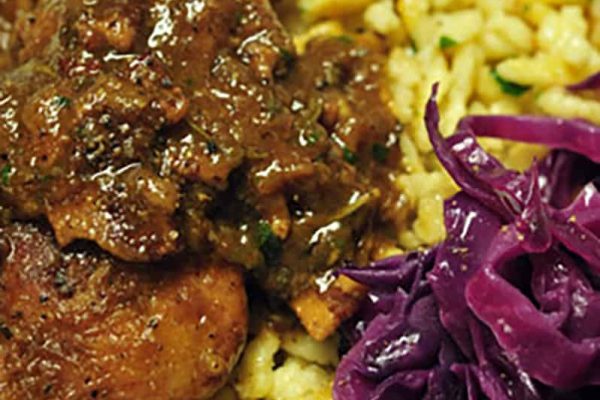It’s always fun to come up with a menu based on a single ingredient. Sometimes it’s the protein, sometimes it’s a vegetable. This time around the recipe was based on something that wouldn’t even end up in the recipe!
Enter the Gewurztraminer (pronounced gə-ˈvu̇rt-ˌstra-mə-nər). We tasted a bottle at our local wine shop and loved it! I immediately knew it needed a dinner in its honor. But what? Sausages seemed a bit too much work, schnitzel required frying so maybe a stew. Hasenpfeffer popped into my head, but rabbits aren’t easily found at my local grocery and I just happened to have a whole free-range local chicken broken down in my freezer. I figured chicken was a pretty good substitute for rabbit and the weight was even pretty spot on!
I looked up the German word for chicken, which is hahnchen and sure enough there is already a hahnchenpfeffer in German cuisine. The recipe I chose is from chefs-table.homebrewchef.com and is exactly their recipe (including the photo as I somehow did not manage to take a good one) except the chicken substitute. It came out delicious! I served it over Bavarian-Style Spaetzle and paired it with braised red cabbage and a mustardy potato bake oh and of course a delicious Gewurztraminer.
Ingredients:
1/2 pound bacon, smoked, thick cut, chopped into 1/2 inch pieces
4 – 5 pound rabbit, fresh, cut into six pieces (2 legs, 2 hind quarters, 2 breast | rib)
2 teaspoon salt, kosher
1 teaspoon peppercorns, black, freshly cracked
1/2 cup flour, all-purpose
1 cup shallots peeled and diced
2 tablespoon thyme leaves, fresh
1 tablespoon rosemary, leaves, fresh
1 tablespoon savory, leaves, fresh
10 each peppercorns, black, cracked
2 each bay leaves preferably fresh
2 each garlic, cloves peeled and minced
2 each cloves, whole
22 ounce Dunkel Weisse, such as Dunkelweizen
2 cup stock, chicken, or vegetable stock
2 teaspoon lemon juice
2 tablespoon flour, all-purpose
1 tablespoon parsley, Italian leaf leaves only,
1/2 teaspoon salt, kosher
Instructions:
In a large Dutch oven over medium heat, add the cut bacon. Stir somewhat frequently to help the bacon cook evenly and to help render out the fat. Once the bacon is lightly crisp, but not burnt, remove it from the pot. Leave behind as much grease in the pot as possible.
While the bacon is rendering, cut up the rabbit and season with the salt and pepper to coat. Using your hands, rub the seasoning into all over the rabbit pieces. Next, dredge each piece of meat in the flour, coating evenly on all sides, and place into the pan with the drippings. Add enough pieces to cover the bottom, not letting the pieces touch. Cook for 6 – 7 minutes on each side to form a nice golden brown crust and set aside on a clean plate. Repeat process until all the meat is cooked. If the bottom of the pan starts to have lots of burnt flour bits, the heat is too high. Clean the pan before continuing with the dish.
Preheat the oven to 300°F | 149°C. Add the shallots, stirring to coat evenly in the remaining drippings, cooking for 7 minutes to caramelize them. Add the thyme, rosemary, savory, peppercorns, garlic and cloves, stirring to incorporate, and cook for 2 minutes to soften the garlic a touch. Season with salt and pepper. Deglaze the pot with the Dunkelweizen, scraping the bottom of any browned bits. Add the stock and browned rabbit into the pot, bringing the mixture to a simmer. Cover the Dutch oven with a tight- fitting lid and place in the center of the heated oven. Cook for about 2 hours, depending on how accurate the oven temperature is. The rabbit should be fork tender, but not completely falling off the bone. Remove from the oven and place onto a burner, over medium heat. Carefully remove the rabbit pieces to a plate. If there is not very much braising liquid left, add more beer or stock to the pot. Add lemon juice (to add a touch of acidity to the sauce) and sprinkle in the flour and parsley. Using a whisk, stir as the liquid comes to a boil. The sauce will thicken as it cooks for 1 – 2 minutes, cooking out the starchy taste of the flour. The sauce should be the consistency of gravy. Add more beer | stock if too thick or flour if to thin, to adjust the consistency. Taste and season with salt and pepper if needed.

